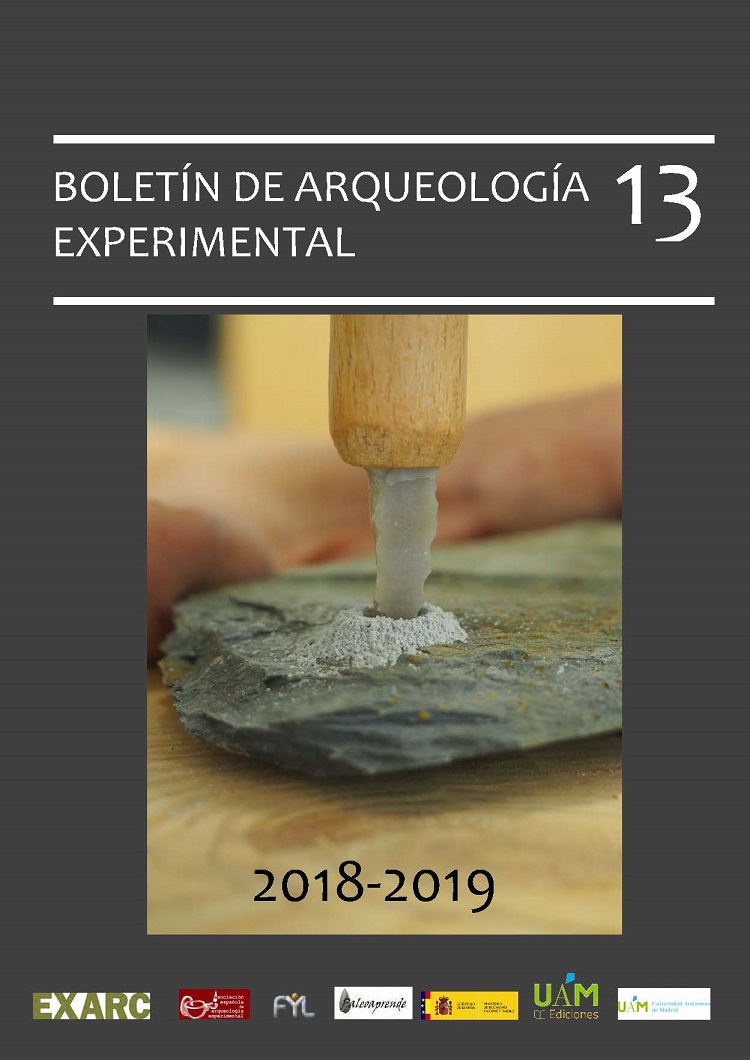Keywords:
raw materials, porcelain, lithic knappingAbstract
This work presents the results of a controlled experience on porcelain nodules manufacture using two types of porcelain clay and different colours. The experience has two main objectives in order to carry out future experimental programs. The first goal is to compare and choose which type of clay offers better results on knapping with different hammers. The second objective is to test the visibility of knapping stigmas in different colours. A third objective that underlies this experience is to reach the Experimental Archaeology Laboratory self-sufficiency by acquiring the skill of porcelain nodules manufacture.
Downloads
References
BAENA, J. y GONZÁLEZ, J. (1998): "Las materias primas". En J. BAENA (coord.). Talla lítica experimental. Introducción a la talla de utillaje prehistórico. BAR International Series, 721: 19-26. Oxford.
COTTERELL, B. (2010): Fracture and Life. Imperial College Press, Londres.
https://doi.org/10.1142/9781848162839
CRABTREE, D. E. (1971): "Notes on Experiments in Flintknapping 3: the flintknappers raw material". En CRABTREE, D. E. Experiments in Flintworking: 8-24. Idaho State University Museum, Pocatello.
DAVIS, A. J. y SHEA, J. J. (1988): "Quantifying Lithic Curation: an Experimental Test of Dibble and Pelcin's Original Flake-Tool Mass Predictor". Journal of Archaeological Science, 25: 603-610.
https://doi.org/10.1006/jasc.1997.0255
DIBBLE, H. L. y PELCIN, A. (1995): "The Effect of Hammer Mass and Velocity on Flake Mass". Journal of Archaeological Science, 22: 429-439.
https://doi.org/10.1006/jasc.1995.0042
DIBBLE, H. L. y WHITTAKER, J. (1981): "New experimental evidence on the relation between percussion flaking flake variation". Journal of Archaeological Science, 6: 283-296.
https://doi.org/10.1016/0305-4403(81)90004-2
Geribàs, N.; Mosquera, M. y Vergès, J. M. (2010): "What Novice Knappers Have to Learn to Become Expert Stone Toolmakers". Journal of Archaeological Science, 37: 2857-2870
https://doi.org/10.1016/j.jas.2010.06.026
HARWOOD, R. y CRANDELL, O. (2010): "Practical Applications of Dekton Artificial Rock for Experimental Archaeology and Traditional Lithic Technology". [Online]. Puget Sound Knappers http://pugetsoundknappers.com/interesting_stuff/Dekton.html. [Último acceso 15/03/2019]
KHREISHEH, N. N.; DAVIES, D. y BRADLEY, B. A. (2013): "Extending experimental control: the use of porcelain in flaked stone experimentation". Advances in Archaeological Practice, 1(1): 38-46.
https://doi.org/10.7183/2326-3768.1.1.37
ROY, B. (2009): "Prehistoric sites in Mandla, Madhya Pradesh (India), with evidence of using modern materials". Hukay, 14: 25-46.
SPETH, J. (1972): "Mechanical basis of percussion flaking". American Antiquity, 37: 34-60.
https://doi.org/10.2307/278884
WHITTAKER, J. C. (1994): "Flintknapping: Making and Understanding Stone Tools". University of Texas Press, Austin.
WHITTAKER, J. y STAFFORD, M. (1999): "Replicas, Fakes, and Art: the Twentieth Century Stone Age and its Effects on Archaeology". American Antiquity, 64(2): 203-214.

